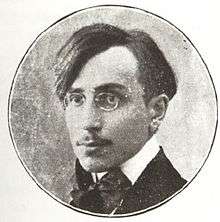Kegham Parseghian
Kegham Parseghian (Գեղամ Բարսեղեան) (1883, Constantinople, Ottoman Turkey – 1915 Ayaş, Ottoman Turkey), was an Armenian writer, teacher, editor, and journalist.[1]
Kegham Parseghian Գեղամ Բարսեղեան | |
|---|---|
 | |
| Born | 1883 Constantinople, Ottoman Turkey |
| Died | 1915 (aged 31–32) (aged 32) Ayaş, Ottoman Turkey |
| Occupation | Journalist, writer, teacher, and political activist. |
Biography
Kegham Parseghian was born in the Gedik Paşa district of Constantinople. He attended the local Mesrobian school and continued his studies at the Getronagan Varjaran (Central Lyceum) until 1896. After spending a year in Paris, he published his first literary pieces in Armenian periodicals and newspapers of the time. Then he became a chief columnist and editor of the newspapers Surhantag (Սուրհանդակ) and Azatamart (Ազատամարտ, 1909-1915). He was one of the editors of the literary review Aztag (Ազդակ, 1908-1909). He was one of the founding members of the short lived literary monthly Mehian (Մեհեան, 1914) and worked along famed writers such as Gostan Zarian, Daniel Varujan, Hagop Oshagan, Hrand Nazariantz and Aharon Dadurian.[1]
A complete collection of his works was published in 1931 by the Society of Friends of Martyred Writers in Paris.[1]
During the Armenian Genocide, on April 24, 1915, Parseghian was apprehended and taken to Ayaş near Ankara where he was killed.[2]
References
- Hacikyan, Agop; Gabriel Basmajian; Edward S. Franchuk (2005). Nourhan Ouzounian (ed.). The Heritage of Armenian Literature Volume III: From the Eighteenth Century to Modern Times. Detroit, MI: Wayne State University Press. pp. 826–827. ISBN 0-8143-2815-6. Retrieved 19 October 2011.
- Georges Balakian: Le Golgotha arménien, Le cercle d'écrits caucasiens, La Ferté-Sous-Jouarre 2002 (vol. 1) ISBN 2-913564-08-9 pp. 87-94